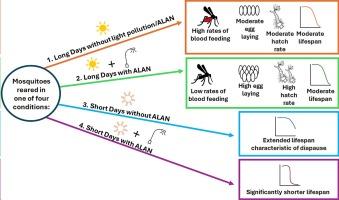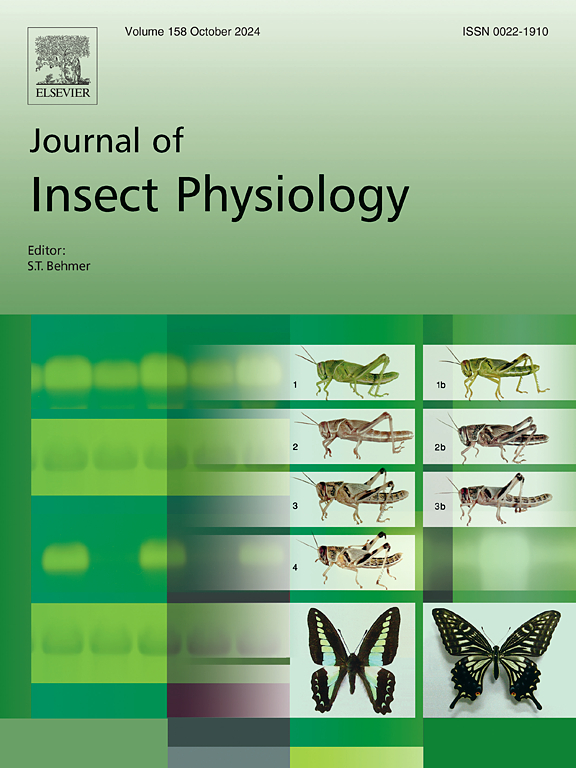光污染会扰乱西尼罗河病媒库蚊的季节性繁殖表型并缩短其寿命。
IF 2.3
2区 农林科学
Q1 ENTOMOLOGY
引用次数: 0
摘要
北方家蚊(Culex pipiens)的雌蚊是重要的疾病传播媒介,因为它们传播包括西尼罗河病毒在内的病原体。这些雌蚊通过进入休眠期(一种休眠状态)来度过冬天,休眠期的特点是脂质积累、停止吸血和生殖停止。休眠是由光周期引起的,因此当夏末秋初白天变短时,雌性蝰蛇就会准备越冬,疾病传播也会减少。我们以前曾证实,夜间人工光照(ALAN)会使雌性蝰蛇在短日照条件下避免休眠并继续吸血。此外,光污染会改变蚊子活动和营养储备的季节性差异。然而,目前还不清楚暴露于 ALAN 如何影响长日照条件下饲养的雌蚊的采血和繁殖力,以及暴露于短日照和长日照条件下的蝰蛇的存活率。在这项研究中,我们假设在长日照条件下暴露于 ALAN 的雌性会有较低的吸血倾向、繁殖力下降和存活率降低。我们在实验室进行的实验结果表明,在长日照条件下暴露于ALAN的雌性比未暴露于ALAN的长日照饲养雌性更少吸血,但繁殖力更强,而且暴露于ALAN不会影响长日照饲养雌性的寿命。此外,我们假设在短日照条件下暴露于ALAN会降低存活率,我们的数据也支持这一假设。总之,我们的研究结果表明,ALAN是一种重要的城市压力源,有可能影响蚊子的繁殖和寿命,因此有可能造成进化上的权衡。本文章由计算机程序翻译,如有差异,请以英文原文为准。

Light pollution disrupts seasonal reproductive phenotypes and reduces lifespan in the West Nile vector, Culex pipiens
Females of the Northern House mosquito, Culex pipiens, are important disease vectors as they transmit pathogens including West Nile virus. These females survive the winter by entering diapause, a state of dormancy, characterized by the accumulation of lipids, cessation of blood-feeding, and reproductive arrest. Diapause is cued by photoperiod, so as days become short in late summer and early fall, female Cx. pipiens prepare to overwinter and disease transmission decreases. We previously demonstrated that Artificial light at night (ALAN) causes female Cx. pipiens to avert diapause and continue to blood-feed when reared under short-day conditions. Additionally, light pollution alters seasonal differences in mosquito activity and nutrient reserves. However, it is unclear how exposure to ALAN affects blood-feeding and fecundity in long-day reared females, as well as the survival of Cx. pipiens exposed under both short and long-day conditions. In this study, we hypothesized that females exposed to ALAN in long-day conditions would have a lower proclivity to blood-feed, reduced fecundity, and reduced survival. Results from our lab-based experiments demonstrate that females exposed to ALAN in long-day conditions were less likely to blood-feed but were more fecund than long-day reared females that were not exposed to ALAN, and that ALAN exposure did not affect lifespan of long-day reared females. Additionally, we hypothesized ALAN exposure under short-day conditions would reduce survival, and our data supports this hypothesis. Overall, our results demonstrate that ALAN is an important urban stressor that has the potential to affect reproduction and lifespan in mosquitoes, and therefore has the potential to create evolutionary tradeoffs.
求助全文
通过发布文献求助,成功后即可免费获取论文全文。
去求助
来源期刊

Journal of insect physiology
生物-昆虫学
CiteScore
4.50
自引率
4.50%
发文量
77
审稿时长
57 days
期刊介绍:
All aspects of insect physiology are published in this journal which will also accept papers on the physiology of other arthropods, if the referees consider the work to be of general interest. The coverage includes endocrinology (in relation to moulting, reproduction and metabolism), pheromones, neurobiology (cellular, integrative and developmental), physiological pharmacology, nutrition (food selection, digestion and absorption), homeostasis, excretion, reproduction and behaviour. Papers covering functional genomics and molecular approaches to physiological problems will also be included. Communications on structure and applied entomology can be published if the subject matter has an explicit bearing on the physiology of arthropods. Review articles and novel method papers are also welcomed.
 求助内容:
求助内容: 应助结果提醒方式:
应助结果提醒方式:


